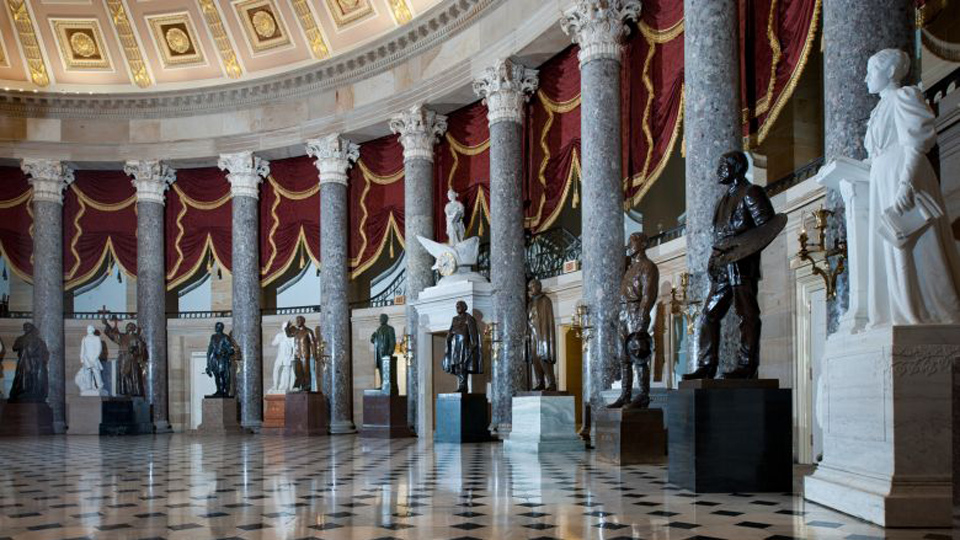
WASHINGTON — The right-wing riot in Charlottesville, Va. – centered around defending a statue of Confederate Gen. Robert E. Lee — which saw a neo-Nazi murder one young counter-protesting woman with his car and injure 19 others, has led House Minority Leader Nancy Pelosi, D-Calif., to demand removal of Confederates’ statues from the U.S. Capitol.
And her demand points up the predominance of statues of white male politicians and military leaders, including the rebels, in those halls, contrasted to only nine women, one African-American, one Latino and no labor leaders.
“Confederate statues in the halls of Congress have always been reprehensible,” Pelosi said on August 17, five days after the right-wingers – an amalgamation of neo-Nazis, white supremacists, KKK members and so-called alt-rightists – invaded Charlottesville, ostensibly to defend the Lee statue there.
“If Republicans are serious about rejecting white supremacy, I call upon” GOP House “Speaker Ryan to join Democrats to remove the Confederate statues from the Capitol immediately,” she said.
“There is no room for celebrating the violent bigotry of the men of the Confederacy in the hallowed halls of the United States Capitol or in places of honor across the country,” Pelosi added.
The riot and subsequent inflammatory rhetoric by GOP President Donald Trump prompted even Republican lawmakers to say they reject white supremacy. Pelosi suggested that if they want to do so, they start with the statues right under their very noses.
The list of rebel statues in the hall – which was the old U.S. House chamber until the Capitol was expanded in 1859 – and in surrounding corridors includes not just Lee, who’s now nearby. Estimates of the number of rebels range from a dozen to 17.
Among the others: Confederate President Jeff Davis, Confederate Vice President Alexander Stephens, Gen. Wade Hampton of South Carolina, at least six with lesser ranks, and John C. Calhoun, also from South Carolina. He died in 1850 but was the intellectual father of rebellion and secession.
By contrast, there are no labor leaders. No Eugene Debs, whom Indiana could have sent. No Walter Reuther from Michigan. No Samuel Gompers from New York. No Cesar Chavez from California.
The only African-American statue is of Rosa Parks, memorialized by Alabama. The sole Latino is the late Sen. Dennis Chavez of New Mexico. The nine women include Parks, Helen Keller, Sacagawea and Frances Willard. Willard campaigned for the women’s right to vote, and for Prohibition.
There are two inventors – Thomas Alva Edison and Robert Fulton – and five Presidents in the hall and corridors: Washington, Jackson, Eisenhower, Reagan and Ford.
Though Pelosi did not say so, there’s another sculpture of three women’s suffrage leaders, shown in above-the-waist profiles side-by-side carved out of a large block of marble: Elizabeth Cady Stanton, Lucretia Mott and Susan B. Anthony. The block is so large and lifeless it’s been derisively nicknamed “three women in a bathtub.”
In demanding the removal of the rebel leaders’ statues, Pelosi talked about what she did in this regard during her tenure as speaker of the House. She noted when she was House Speaker, “We recognized more women and people of color in Congress’ collection of statues, including Rosa Parks, Sojourner Truth and Helen Keller. As Speaker, we relocated Robert E. Lee out of a place of honor in Statuary Hall – a place now occupied by the statue of Rosa Parks.” But Sojourner Truth has a bust, not a statue, far from Statuary Hall, in the Capitol Visitors Center.
Since 2006, states, which are allowed two statues each, can replace prior statues with new ones. Five have done so, which is how Ike, Reagan and Ford wound up in Statuary Hall. And Wikipedia notes the Mott-Stanton-Anthony sculpture was moved out of the basement to a place of honor: The Rotunda.
Since the Charlottesville riot, the Office of the Architect of the Capitol, which oversees the building, and the statues, has had no comment on who should be memorialized, and did not respond to an email about the issue.

MOST POPULAR TODAY

High Court essentially bans demonstrations, freedom of assembly in Deep South

Zionist organizations leading campaign to stop ceasefire resolutions in D.C. area

UN warns that Israel is still blocking humanitarian aid to Gaza

U.S. imperialism’s ‘ironclad’ support for Israel increases fascist danger at home







Comments